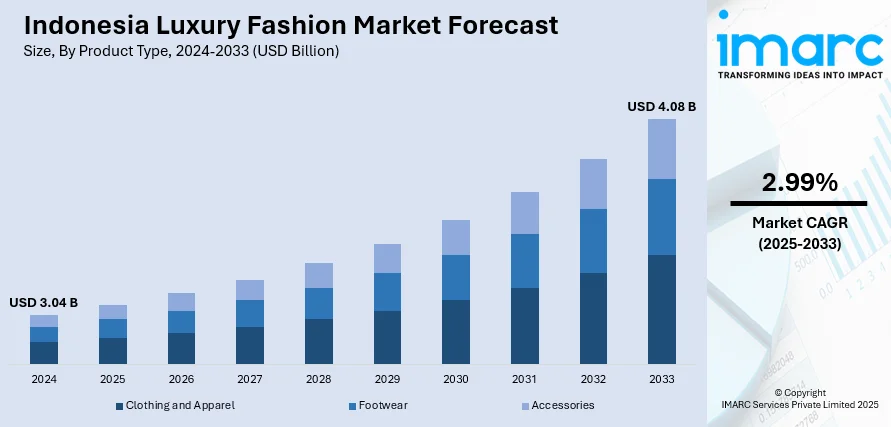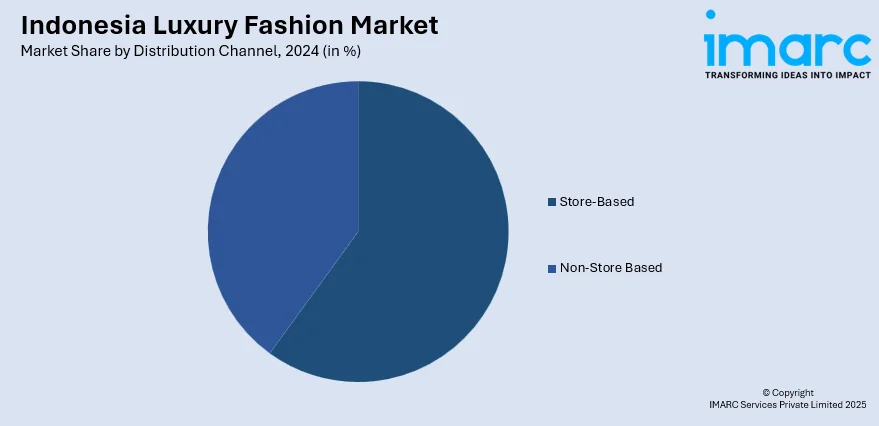
Indonesia Luxury Fashion Market Size, Share, Trends and Forecast by Product Type, Distribution Channel, End User, and Region, 2025-2033
Indonesia Luxury Fashion Market Overview:
The Indonesia luxury fashion market size reached USD 3.04 Billion in 2024. The market is projected to reach USD 4.08 Billion by 2033, exhibiting a growth rate (CAGR) of 2.99% during 2025-2033. The market is fueled by increasing disposable incomes, growing middle-class populations, and the growing popularity of international fashion trends among young consumers. In addition, the country's digital revolution and larger e-commerce ecosystem have increased luxury brand visibility, allowing global labels to reach directly more consumers. Along with this, the rise in the number of high-end millennials and Gen Z shoppers focusing on premium experiences and status-oriented spending is augmenting the Indonesia luxury fashion market share.
|
Report Attribute
|
Key Statistics
|
|---|---|
|
Base Year
|
2024
|
|
Forecast Years
|
2025-2033
|
|
Historical Years
|
2019-2024
|
| Market Size in 2024 | USD 3.04 Billion |
| Market Forecast in 2033 | USD 4.08 Billion |
| Market Growth Rate 2025-2033 | 2.99% |
Indonesia Luxury Fashion Market Trends:
Digital Acceleration and E-Commerce Integration
The market is seeing a drastic transformation due to the fast adoption of digital platforms and the expansion of e-commerce. As per industry reports, Indonesia had 185.3 Million internet users with an internet penetration of 66.5% as of early 2024. While internet penetration keeps growing in urban and semi-urban zones, high-end brands are using online stores to tap into a wider, digitally literate base. Consumers are relying heavily on mobile applications, social media sites, and live streaming events to find, compare, and buy luxury goods. Moreover, domestic and international e-commerce sites like Tokopedia, Shopee, and Zalora have introduced luxury standalone segments to meet this need. In addition, global brands are investing in localized digital promotions and mobile-led experiences, such as Bahasa Indonesia content, virtual try-on, and influencer partnerships adapted to the local market. Apart from this, the development of omnichannel retail, when online and offline channels are combined in a harmonious manner, has allowed consumers to shop digitally and touch and feel products in the stores, thereby increasing brand engagement. Apart from this, the digital transformation also prompted data-driven personalization, providing curated suggestions and special product drops to foster customer loyalty and enhance conversion rates.

To get more information on this market, Request Sample
Rise of Affluent Millennials and Gen Z Consumers
The growing economic influence of affluent millennials and Gen Z consumers is shaping the Indonesia luxury fashion market growth. Indonesia is currently leveraging a demographic advantage, with 70.72% of its population classified within the productive age bracket of 15 to 64 years. Among the various age cohorts, Generation Z constitutes the largest demographic segment in Indonesia, making up 27.94% of the total population, or approximately 74.93 Million individuals. These younger demographics, particularly in Jakarta, Surabaya, and Bali, are more brand-conscious and attuned to global luxury trends compared to previous generations. They prioritize exclusivity, quality, and brand storytelling, and are more likely to value experiences over traditional status symbols. Apart from this, social media platforms such as Instagram, TikTok, and YouTube serve as influential touchpoints, shaping perceptions of prestige and driving engagement with luxury fashion content. These consumers are highly responsive to sustainability, authenticity, and purpose-driven brand messaging, pushing luxury houses to adapt with ethically sourced materials, transparent supply chains, and inclusive marketing. Moreover, their preference for streetwear, limited-edition collaborations, and custom-made collections is fueling demand for non-traditional luxury formats. As this segment matures, their purchasing power is expected to increase further, prompting both legacy and emerging brands to reimagine their value propositions to maintain relevance and cultivate long-term brand affinity.
Indonesia Luxury Fashion Market Segmentation:
IMARC Group provides an analysis of the key trends in each segment of the market, along with forecasts at the country and regional levels for 2025-2033. Our report has categorized the market based on product type, distribution channel, and end user.
Product Type Insights:
- Clothing and Apparel
- Jackets and Coats
- Skirts
- Shirts and T-Shirts
- Dresses
- Trousers and Shorts
- Denim
- Underwear and Lingerie
- Others
- Footwear
- Accessories
- Gems and Jewellery
- Belts
- Bags
- Watches
The report has provided a detailed breakup and analysis of the market based on the product type. This includes clothing and apparel (jackets and coats, skirts, shirts and T-shirts, dresses, trousers and shorts, denim, underwear and lingerie, and others), footwear, and accessories (gems and jewellery, belts, bags, and watches).
Distribution Channel Insights:

- Store-Based
- Non-Store Based
A detailed breakup and analysis of the market based on the distribution channel have also been provided in the report. This includes store-based and non-store based.
End User Insights:
- Men
- Women
- Unisex
The report has provided a detailed breakup and analysis of the market based on the end user. This includes men, women, and unisex.
Regional Insights:
- Java
- Sumatra
- Kalimantan
- Sulawesi
- Others
The report has also provided a comprehensive analysis of all the major regional markets, which include Java, Sumatra, Kalimantan, Sulawesi, and others.
Competitive Landscape:
The market research report has also provided a comprehensive analysis of the competitive landscape. Competitive analysis such as market structure, key player positioning, top winning strategies, competitive dashboard, and company evaluation quadrant has been covered in the report. Also, detailed profiles of all major companies have been provided.
Indonesia Luxury Fashion Market News:
- February 2025, Arc’teryx, the global leader in high-performance outdoor apparel, officially launched its presence in Indonesia by opening its first store at Beachwalk Shopping Center in Bali. Arc’teryx aims to cater to Indonesia’s growing outdoor community by offering cutting-edge, climate-adapted technical gear, including waterproof, breathable, and UV-protective apparel, while incorporating interactive brand activations and expert consultations at the store launch.
Indonesia Luxury Fashion Market Report Coverage:
| Report Features | Details |
|---|---|
| Base Year of the Analysis | 2024 |
| Historical Period | 2019-2024 |
| Forecast Period | 2025-2033 |
| Units | Billion USD |
| Scope of the Report | Exploration of Historical Trends and Market Outlook, Industry Catalysts and Challenges, Segment-Wise Historical and Future Market Assessment:
|
| Product Types Covered |
|
| Distribution Channels Covered | Store-Based, Non-Store Based |
| End Users Covered | Men, Women, Unisex |
| Regions Covered | Java, Sumatra, Kalimantan, Sulawesi, Others |
| Customization Scope | 10% Free Customization |
| Post-Sale Analyst Support | 10-12 Weeks |
| Delivery Format | PDF and Excel through Email (We can also provide the editable version of the report in PPT/Word format on special request) |
Key Questions Answered in This Report:
- How has the Indonesia luxury fashion market performed so far and how will it perform in the coming years?
- What is the breakup of the Indonesia luxury fashion market on the basis of product type?
- What is the breakup of the Indonesia luxury fashion market on the basis of distribution channel?
- What is the breakup of the Indonesia luxury fashion market on the basis of end user?
- What is the breakup of the Indonesia luxury fashion market on the basis of region?
- What are the various stages in the value chain of the Indonesia luxury fashion market?
- What are the key driving factors and challenges in the Indonesia luxury fashion market?
- What is the structure of the Indonesia luxury fashion market and who are the key players?
- What is the degree of competition in the Indonesia luxury fashion market?
Key Benefits for Stakeholders:
- IMARC’s industry report offers a comprehensive quantitative analysis of various market segments, historical and current market trends, market forecasts, and dynamics of the Indonesia luxury fashion market from 2019-2033.
- The research report provides the latest information on the market drivers, challenges, and opportunities in the Indonesia luxury fashion market.
- Porter's five forces analysis assist stakeholders in assessing the impact of new entrants, competitive rivalry, supplier power, buyer power, and the threat of substitution. It helps stakeholders to analyze the level of competition within the Indonesia luxury fashion industry and its attractiveness.
- Competitive landscape allows stakeholders to understand their competitive environment and provides an insight into the current positions of key players in the market.
Need more help?
- Speak to our experienced analysts for insights on the current market scenarios.
- Include additional segments and countries to customize the report as per your requirement.
- Gain an unparalleled competitive advantage in your domain by understanding how to utilize the report and positively impacting your operations and revenue.
- For further assistance, please connect with our analysts.
 Request Customization
Request Customization
 Speak to an Analyst
Speak to an Analyst
 Request Brochure
Request Brochure
 Inquire Before Buying
Inquire Before Buying




.webp)




.webp)












